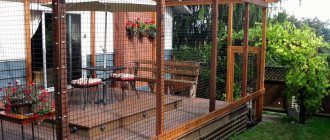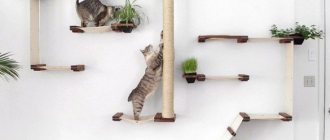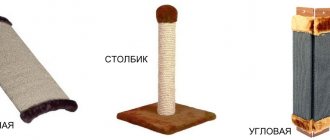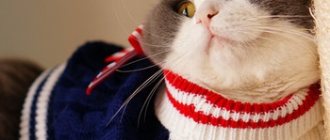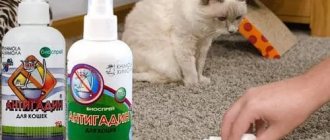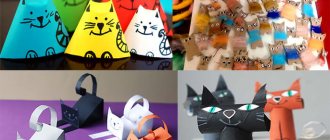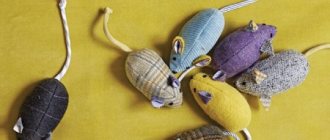Nowadays, one can increasingly observe the trend of building enclosures for cats near private houses and cottages. This is due to the fact that many owners worry about their pets, who may get lost, especially if they previously lived in an apartment. The fashion for such designs came from the USA, where there are enclosures for cats in almost every yard. At the moment, there are many designs of enclosures that differ from each other. This article will discuss their features and design options.
Aviary tasks
As previously mentioned, the idea of building enclosures for cats came to us from America. There they received the name "catio" from the merger of the words "cat" and "yard" in English. Most often, such designs are used for large breed pets.
In our country, it will not be possible to keep cats in such an enclosure all year round, as in the winter months the temperature drops very low, which can even lead to the death of the pet. An aviary is perfect as a seasonal or temporary shelter. The construction of an enclosure is especially relevant for those owners who keep purebred and breeding animals that need to be protected from contact with yard cats and male cats. Such a barrier between animals will avoid pregnancy, fights or infection with many diseases and even the loss of a pet. In this case, the pet will not be inside the apartment or house, but will experience nature.
In the southern regions, enclosures are used all year round to keep cats. So, lovers of our little brothers do not need to worry about the fact that the house will have an unpleasant smell or dirt from a large number of individuals.
There are some breeds that simply need to stay in an enclosure. These include Canadian Sphynxes, Maine Coons, Bengal cats and all pets with exotic roots. These cats simply need space to hunt and develop. Since in an apartment or house, as a rule, there is not enough free space for all the maneuvers of such cats, they experience considerable discomfort from an inferior life in cramped conditions. It is also advisable to arrange, if possible, enclosures for Persian, Scottish, British and Siamese cat breeds, which also need an active life.
Recommendations for location and application
This is the cage of your dreams! Now we just have to figure out where to put this structure. Agree, a do-it-yourself enclosure will not always fit harmoniously into the apartment and interior. However, there are several ways to disguise it.
- To keep the dog's enclosure from being conspicuous, you can design it as a small table or cabinet. To do this, a custom-made countertop to match the interior is placed on the roof. However, this option is only suitable for enclosures with a closed top. But in general it is not recommended to close the enclosure. Therefore, it is better to come up with another way to fit it into the interior.
- It’s good if there is a corner in the apartment where the aviary will fit without problems, will not interfere and will not spoil the appearance of the room.
- Mesh enclosures without a roof can no longer be hidden so easily. But, if you manage to make it foldable, the easiest way is to remove it when not needed.
Where should the enclosure be located so that the dog feels comfortable in it?
- Choose a place where your dog can see most of the apartment.
- Avoid sunny places and drafts. The best option for placing the enclosure is one of the shaded corners of a large room.
- Under no circumstances place the cage near a battery or household appliance.
- The enclosure must be designed in such a way that it can be easily disassembled and transported or removed altogether.
And finally, it’s worth dwelling a little on the rules for using and training a dog in an enclosure. It is possible that the animal will not perceive it as something familiar the first time, so you cannot simply lock the dog in a cage.
- Start by letting the finished enclosure just sit in the room with the door open for some time. The dog must understand that he will not harm her.
- After some time, put your favorite toy or animal treat inside. It may not be right away, but the dog will still go inside for an attractive object. Be sure to praise her.
- After some time, involve the enclosure in games, that is, forcing the dog to bring a toy, periodically throw it into the cage.
- Next, training moves to a more complex level - the dog is taken into a crate and, praising it and treating it with treats, is kept in it. When the animal sits quietly in an open structure for more than 5 minutes, close the door briefly. When the dog is released again, it must be praised and treated.
Range of enclosures
At the moment, there are many different designs of enclosures for cats that can be installed in a suburban area. All of them are divided into several types:
- A stationary enclosure is a large structure that prevents movement around the site. It is a capital structure, equipped with everything necessary. Used in most cases for permanent residence of cats.
- A cage is a portable enclosure structure that is used for the temporary stay of a pet. It is made of metal or wooden rods and can be moved to another place. Such enclosures for cats can be located not only on the site, but also on the balcony or veranda.
- A playpen is a container-type fence that is used as a temporary option to limit a cat’s contact with other animals. Most often it is installed indoors, less often used outdoors. The material for it is not only metal and wood, but also fabric on the frame.
DIY construction
The aviary can be purchased ready-made; now there are a lot of offers. But, if you have the desire, time and materials, you can try to construct the enclosure yourself. There is nothing complicated about this, since, in fact, the fence is built for a cat and in this case the strength characteristics are much lower than, for example, for a dog.
Tools and materials
To build an enclosure for a cat you will need:
- metal mesh with medium-sized cells;
- timber having a cross-section of 50*50 cm. The exact size depends only on the area of the building;
- fastening materials (screws or nails);
- rope and pegs for marking;
- hammer or screwdriver;
- building level;
- metal corner;
- door lock;
- roulette;
- roofing material;
- drainage system.
Important!
Materials for the enclosure should be chosen as safe as possible, without an unpleasant odor, non-toxic and excluding the possibility of injury to the cat. It is worthwhile to dwell in more detail on the mesh used for the enclosure, since it is the main element of the design. There are several types that are equally suitable for making a cat enclosure.
So, chain-link is a budget option that is suitable for building an enclosure, but is not absolutely correct. This happens because the mesh elements are not welded to each other. This allows the cat to get hurt if it climbs on the mesh of the enclosure or sticks its paws into the cells.
Welded mesh is the most suitable material, thanks to which the cat will not be injured. So, if you choose such a mesh with a polymer coating, you can significantly increase the life of the enclosure.
Construction mesh made of stainless steel woven type. This type of mesh is not suitable for enclosures, as it is again dangerous. There is also an all-metal mesh, which is a sheet of metal with holes. In general, it should not be considered as material for an enclosure.
Preparatory work
Before construction, a project for the future structure is always drawn up in order to first carry out the details according to the finished drawing, and then connect them. Typically, a cat enclosure is made in a rectangular shape of the area that is relevant in a particular case. So, each cat should have at least 6 square meters. m.
It is important to pre-coat all wooden parts of the cat enclosure with antiseptic solutions. This will avoid the destruction of the structure due to the impact of external, often unfavorable factors on it, and will also prevent the development of fungus, parasites and mold in the wood.
The site for the construction of an enclosure for cats is also being prepared. It must be cleared of debris, unnecessary plants, bushes, and stumps are uprooted. And also the top layer of soil, which is fertile, must be removed.
Installation algorithm
The installation of an enclosure for cats on the site is carried out using the following technology:
- Marking the area using pegs, tape measure and rope.
- Timber is laid around the perimeter. In this case, each part is secured with a metal corner to the previous one.
- A vertical stand is installed at each corner and fixed with a metal corner.
- Jib beams are assembled from boards.
- The top frame is created by connecting the support beams together with horizontal elements.
- The walls of the future enclosure are measured and a mesh of the required size is cut.
- The perimeter is sheathed with mesh and secured with nails or screws. You can use a construction stapler.
- Excess mesh goes 20 cm into the ground.
- The roof is made of corrugated sheeting or any other material that has been prepared in advance.
Important! The roof of the enclosure must be as strong and reliable as possible to withstand the snow load during the winter months. - The floor is being installed. It can be tiled or covered, for example, with linoleum. Gravel, concrete, or just a lawn can also serve as a floor covering. If you choose grass as a floor covering, you will have to strengthen the enclosure around the perimeter. To do this, it is necessary to pour concrete along the grid, forming it with boards. This will avoid undermining by the cat.
- A drainage system is installed around the entire perimeter of the enclosure to prevent puddles from forming on the floor.
- If you plan to make an enclosure for cats close to the house, then you can provide it with a safe passage that will lead directly into the house. This way, cats can easily get to and from walks.
- After the enclosure is completely ready, it is necessary to carry out its internal arrangement. It should contain houses, play elements, and feeders. To create the filling, the best material would be a sanded board, from which structures can be made at your discretion.
Advice! Several walls of the enclosure can be made solid so that the cats have protection from the wind and a secluded corner.
The most common cat house configurations are similar to dog houses. It is best to place such a house on a low pedestal so that the pet can climb inside. This design will protect the sun, wind and rain, and will also become an excellent place for the animal to rest.
Necessity or whim?
By nature, our favorite furballs, namely cats, are predators. They need a lot of space to train and play. In this case, a cat enclosure is the optimal solution. Quite often, when constructing such structures, a separate place is allocated for the playing area. Loving cat owners create entire playgrounds and even towns, without spending money on expensive materials, but using only boxes.
You can even create an unusual house by sewing it yourself. There are many options, and numerous photos from the Internet serve as proof of this. But why do you need a cat cage and is it really necessary?
Most people are accustomed to taking their animals to their dacha, where they move for the summer. And even if no problems arise during transportation, they may begin after arrival. Usually the problem appears in the form of neighborhood cats who ardently want to meet your kitty. After meeting the village folk, your pet may be rewarded with fleas and even unplanned offspring.
Another danger for pets is stray dogs and cars. According to statistics, animals that live primarily on the street live much shorter lives. This same chance is halved given the fact that your domesticated animal is unlikely to know what to do if attacked and what damage vehicles can cause.
Some tips from the professionals
Those craftsmen who have experience in building enclosures for cats, as a rule, offer beginners to familiarize themselves with tips that will allow them to create the right design where cats will be comfortable:
- The size of the enclosure should be proportionate to the number of pets that will be in it.
- The design of the cat enclosure can be anything that the owner likes and will be comfortable for the pet to live in.
- Materials for the enclosure must be treated with solutions against corrosion and other unpleasant consequences of environmental influences.
- An outdoor structure for cats must have a roof. It is needed not only for protection from bad weather, but also to prevent the cat from jumping over the fence.
- There should be no gaps between the wall and the floor of the enclosure through which a flexible cat can easily slip out.
- The installation of an aviary near the house is carried out in a shaded place. Regardless of the breed, prolonged exposure of a cat to scorching rays can cause health problems for the pet.
- To create comfortable conditions, an enclosure for cats must be equipped with play complexes, houses, drinkers and bowls.
- Regardless of the fact that the animals in the enclosure have limited communication with yard cats, they should be vaccinated and treated for fleas and worms in a timely manner.
- Often a few herbaceous plants or flowers are planted inside the enclosure, which can create shade and act as decoration. But it is worth remembering that there are plants that can harm the health of your pet. These include: hyacinths, ficuses, lilies, irises, hippeastrums, lilies of the valley, evergreen boxwood, jasmine gardenia and ivy. You should refrain from planting these varieties.
How to do it yourself
We will advise you on how to make a fence for a cat in your country house or on the site of a country house with your own hands. First you need to decide on the size and location. The minimum dimensions of such a pen for one cat should be 2x3 meters. We will make the enclosure from metal pipes with a diameter of 1 inch. A fine mesh netting is suitable for walls.
Design requirements
Such an enclosure must comply with all sanitary standards. Even with the smallest dimensions, it must provide space for a toilet tray, a container for food and fresh water. Installing a small house for cats to rest is encouraged. You can equip the interior space with a playground with stairs and multi-tiered shelves, toys tied to them, numerous labyrinths and a place for hiding, and hammocks.
Tools and materials
What materials will be needed when making an aviary:
- metal pipe;
- chain-link mesh, wire to strengthen it;
- wooden beam;
- slate, slate nails;
- self-tapping screws;
- cement, sand, crushed stone.
Tools:
- shovel;
- welding machine;
- drill;
- screwdriver;
- plumb line
Step-by-step instruction
- Mark the dimensions of the enclosure on the selected area, according to the chosen plan, and dig holes around the perimeter at a distance of 1-1.5 meters for installing posts - metal pipes. The length is selected taking into account the roof slope. Provide space for an entrance gate.
- Insert pre-cut posts of a certain length into the holes, strengthen them vertically with crushed stone and concrete.
- We weld the same pipes onto the upper parts of the posts around the perimeter. The roof frame is ready.
- We install the mesh using wire and welding.
- We attach a wooden beam to the upper frame with self-tapping screws.
- All that remains is to lay the slate, securing it securely with slate nails.
- We make a gate separately and hang it on one of the posts using welded hinges, not forgetting about its secure fixation (latch).
- The design of the floor can be different, in our case it is lawn grass. Other options: pea gravel, poured concrete, paving slabs, boardwalks, untreated natural stone walkways.
We made an enclosure using mesh for the walls. We offer another option - to build a similar enclosure next to the country house. Then the wall of the house with the window will simultaneously serve as one of the walls of the enclosure. The animal will have an unhindered opportunity to enter and exit home through the window.
Posting rules
When placing an enclosure in an open space, certain rules should be followed:
- the cage should be located in the shade;
- minimal exposure to wind should be provided;
- locate the structure on a hill to prevent flooding;
- placement preferably in a quiet, secluded corner of the garden.
We hope that our tips will help in caring for your pet.
| Unfortunately, ready-made enclosures for cats are not sold in Russia (if this is not the case, we will be glad to have a link to the store). Only cages of different sizes are available for sale, as well as enclosures for dogs. A cage is not suitable for walking a cat in the summer - sitting in it is torture for a cat, because any cage is still too small. The enclosure for dogs is suitable in size, but, as a rule, such enclosures use a mesh with too large cells - a cat may escape from such an enclosure. You can, of course, buy a dog enclosure and cover it with a more suitable mesh, but it will be quite expensive. Therefore, let’s consider the question of how to make an enclosure for a cat with your own hands. First, we need to purchase materials. Namely:
|
